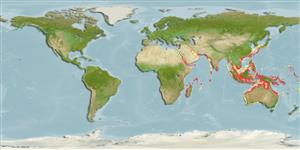Common names from other countries
Environment: milieu / climate zone / depth range / distribution range
Ecologia
marinhas; Água doce; estuarina demersal. Tropical
Indo-West Pacific: Persian Gulf to the Indo-Malayan region, northern Australia, Queensland, and north to southern Japan. Has long been confused with Arius thalassinus (Rüppell 1837).
Tamanho / Peso / Idade
Maturity: Lm ? range ? - ? cm
Max length : 90.0 cm TL macho/indeterminado; (Ref. 114032)
Espinhos dorsais (total) : 1; Espinhos anais: 0; Raios anais : 17 - 21; Vértebras: 53 - 58. Dorsomedian head groove bordered posteriorly by slightly raised frontals and forming a "V". Gill rakers usually absent on hind aspect of first 2 gill arches. Caudal fin lobes slender and tapered. Adipose fin short-based and located posteriorly.
Inhabits coastal waters, from estuaries onto the continental shelf. Found mostly on mudflats; males incubate eggs in its mouth (Ref. 68964). Mainly opportunistic and carnivorous; feeding on sea urchins, crustaceans, fish, prawns, loose scales, and detritus (Ref. 38478). Has a sharp and venomous dorsal and pectoral spines that can inflict extremely painful injuries(Ref. 68964). An important food fish (Ref. 7050).
Ciclo de vida ou comportamento de acasalamento
Maturities | Reprodução | Spawnings | Egg(s) | Fecundities | Larvas
Kailola, P.J., 1999. Ariidae (=Tachysuridae): sea catfishes (fork-tailed catfishes). p. 1827-1879. In K.E. Carpenter and V.H. Niem (eds.) FAO species identification guide for fishery purposes. The living marine resources of the Western Central Pacific. Vol. 3. Batoid fishes, chimaeras and bony fishes part 1 (Elopidae to Linophrynidae). FAO, Rome. (Ref. 38478)
Status na Lista Vermelha da UICN (Ref. 130435)
CITES (Ref. 128078)
Not Evaluated
Ameaça para os humanos
Traumatogenic (Ref. 58010)
Uso pelos humanos
Pescarias: pouco comercial
Ferramentas
Relatórios especiais
Baixar XML
Fontes da internet
Estimates based on models
Preferred temperature (Ref.
115969): 24.6 - 29.2, mean 28.3 (based on 1456 cells).
Índice de diversidade filogenética (Ref.
82804): PD
50 = 0.6250 [Uniqueness, from 0.5 = low to 2.0 = high].
Bayesian length-weight: a=0.00813 (0.00384 - 0.01719), b=3.06 (2.88 - 3.24), in cm Total Length, based on LWR estimates for this (Sub)family-body shape (Ref.
93245).
Nível Trófico (Ref.
69278): 3.8 ±0.49 se; based on food items.
Resiliência (Ref.
120179): Baixo, tempo mínimo de duplicação da população 4,5 - 14 anos (Preliminary K or Fecundity.).
Fishing Vulnerability (Ref.
59153): High vulnerability (56 of 100).
